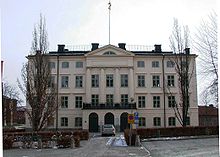State Institute for Racial Biology
You can help expand this article with text translated from the corresponding article in Swedish. (February 2020) Click [show] for important translation instructions. |

| This article is part of a series on the |
| Eugenics Movement |
|---|
The State Institute for Racial Biology (SIRB, Swedish: Statens institut för rasbiologi, SIFR) was a Swedish governmental research institute founded in 1922 with the stated purpose of studying eugenics and human genetics. It was the most prominent institution for the study of "racial science" in Sweden.[1] It was located in Uppsala. In 1958, it was renamed to the State Institute for Human Genetics[2] (Institutionen för medicinisk genetik) and is today incorporated as a department of Uppsala University.
The institute's first head was Herman Lundborg.[3] He retired in 1935. He was succeeded by Gunnar Dahlberg.[1] An early research priority was studying the commonness of the "Nordic" racial traits in the Swedish population and the alleged downsides of race-mixing between the majority population and Finns and the Sámi people.[1][4] Between 1936 and 1960, the majority of research projects at SIRB concerned medical genetics but racial science was still an important aspect of the institute.[1]
History
[edit]
After its founding in 1922, it continued under the leadership of Herman Lundborg. In 1926, studies conducted by the institute provided a basis for Lundborg's upper secondary school textbook Swedish Racial Studies. However, Lundborg became increasingly antisemitic which put him at odds with the Swedish Government during a time when tensions were growing between Sweden and Germany. In 1936, he was replaced by Gunnar Dahlberg. In 1959 it was integrated into Uppsala University, and is today the university's genetic center.
The official assignment of the Swedish institute was to study the inhabitants of the country from a racial perspective. They studied the life conditions and environmental developments of different families in an attempt to explain the effects of biological heritage and the environment. They also studied mental illnesses, alcoholism and criminality.
Svenska sällskapet för rashygien (Swedish Society for Eugenics) was founded in 1909 and paved the way for SIRB. Its mission statement was to study eugenics. Svenska sällskapet för rashygien, and eugenics in general, did not gain ground until after World War I. In 1918 the society travelled around Sweden with an exhibit called Folktyputställning ('Exhibition on types of people'). The same year Frithiof Lennmalm, head of the Karolinska Institute, proposed that the Nobel Foundation finance an institute for race biology. The Nobel committee for medicine voted unanimously in favour of the proposal. The staff of the Karolinska Institute voted against it by a very thin margin (9 against 8). Instead it was proposed that the Swedish state found and finance such an institute.
See also
[edit]References
[edit]- ^ Jump up to: a b c d Ericsson, Martin (2020-06-30). "What happened to 'race' in race biology? The Swedish State Institute for Race Biology, 1936−1960". Scandinavian Journal of History. 46: 125–148. doi:10.1080/03468755.2020.1778520. ISSN 0346-8755.
- ^ According to the title page of the dissertation of Lars Beckman A Contribution to the Physical Anthropology and Population Genetics of Sweden: Variations of the ABO, Rh, MN and P Blood Groups. Hereditas (Lund), ISSN 0018-0661 ; 45(1959) the name of the institute in 1959 was The State Institute for Human Genetics and not the Institute for Medical Genetics.
- ^ Hagerman, Maja (November 2020). Herman Lundborg Rätsel eines Rassenbiologen. BWV Berliner Wissenschafts-Verlag GmbH (1 Auflage ed.). Berlin. ISBN 978-3-8305-3986-5. OCLC 1140427053.
{{cite book}}: CS1 maint: location missing publisher (link) - ^ Hagerman, M. A racial biologist in Laponia, in Writing the North of the North : construction of images, confrontation of reality and location in the literary field = L'Écriture du Nord du Nord : construction d'images, confrontation au réel et positionnement dans le champ littéraire = Den Norden des Nordens (be-)schreiben : Bildkonstruktion, Wirklichkeitsbezug und Positionierung im literarischen Feld. Bourguignon, Annie, Harrer, Konrad. Berlin. 29 November 2019. ISBN 978-3-7329-0625-3. OCLC 1138109494.
{{cite book}}: CS1 maint: location missing publisher (link) CS1 maint: others (link)
